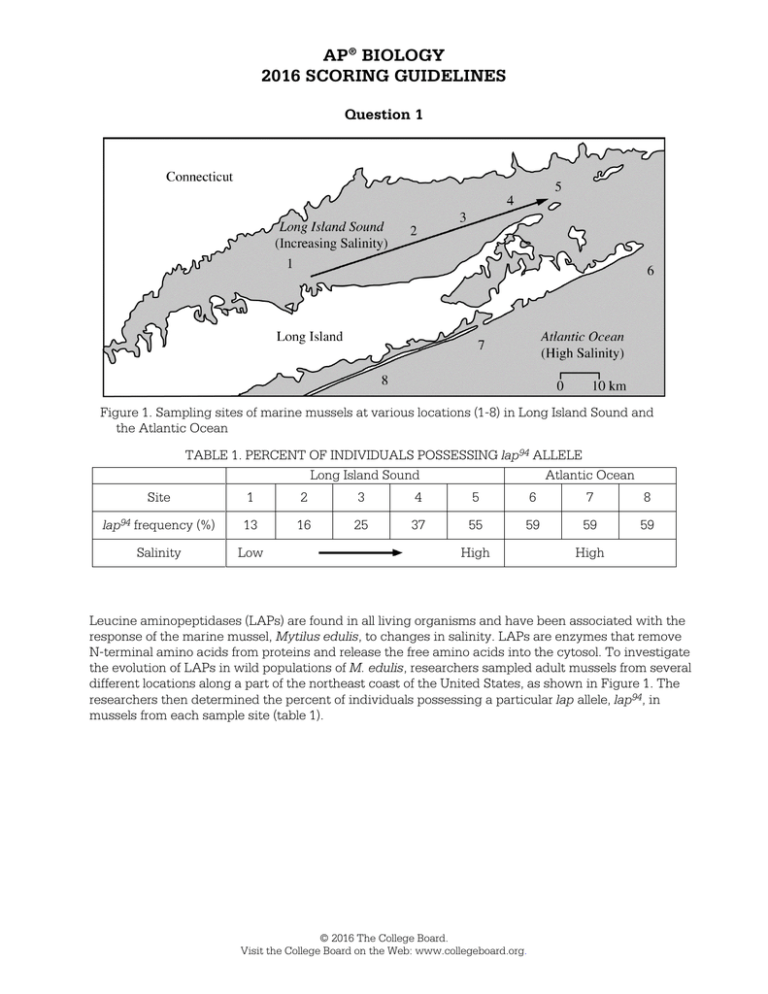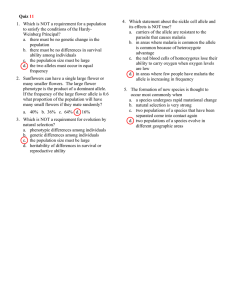AP Biology Student Samples (2016) – Question 1
advertisement

AP® BIOLOGY 2016 SCORING GUIDELINES Question 1 Figure 1. Sampling sites of marine mussels at various locations (1-8) in Long Island Sound and the Atlantic Ocean TABLE 1. PERCENT OF INDIVIDUALS POSSESSING lap94 ALLELE Long Island Sound Atlantic Ocean Site 1 2 3 4 5 6 7 8 lap94 frequency (%) 13 16 25 37 55 59 59 59 Salinity Low High High Leucine aminopeptidases (LAPs) are found in all living organisms and have been associated with the response of the marine mussel, Mytilus edulis, to changes in salinity. LAPs are enzymes that remove N-terminal amino acids from proteins and release the free amino acids into the cytosol. To investigate the evolution of LAPs in wild populations of M. edulis, researchers sampled adult mussels from several different locations along a part of the northeast coast of the United States, as shown in Figure 1. The researchers then determined the percent of individuals possessing a particular lap allele, lap94, in mussels from each sample site (table 1). © 2016 The College Board. Visit the College Board on the Web: www.collegeboard.org. AP® BIOLOGY 2016 SCORING GUIDELINES Question 1 (continued) (a) On the axes provided, construct an appropriately labeled bar graph to illustrate the observed frequencies of the lap94 allele in the study populations. (3 points) Construct graph (3 points) • Correctly plotted bar graph that accurately represents the trend • Correct axis labeling • Correct scale and units (b) Based on the data, describe the most likely effect of salinity on the frequency of the lap94 allele in the marine mussel populations in Long Island Sound. Predict the likely lap94 allele frequency at a sampling site between site 1 and site 2 in Long Island Sound. (2 points) Description (1 point) • As salinity increases lap94 frequency increases • As salinity decreases lap94 frequency decreases Prediction (1 point) Between 13 and 16 percent (or a selected value between 13 and 16 percent) (c) Describe the most likely effect of LAP94 activity on the osmolarity of the cytosol. Describe the function of LAP94 in maintaining water balance in the mussels living in the Atlantic Ocean. (2 points) Describe effect of LAP94 activity (1 point) • LAP94 increases osmolarity/solute concentration of the cytosol • LAP94 decreases water potential of the cytosol Describe function of LAP94 in maintaining water balance (1 point) Prevents water loss to the environment (d) Marine mussel larvae are evenly dispersed throughout the study area by water movement. As larvae mature, they attach to the rocks in the water. Explain the differences in lap94 allele frequency among adult mussel populations at the sample sites despite the dispersal of larvae throughout the entire study area. Predict the likely effect on distribution of mussels in Long Island Sound if the lap94 allele was found in all of the mussels in the population. Justify your prediction. (3 points) • • Explanation (1 point) Mussels with lap94 allele are more likely to survive in high salinity/less likely to survive in low salinity. Mussels without lap94 allele are less likely to survive in high salinity/more likely to survive in low salinity. • • Prediction (1 point) Mussel population will increase in high salinity. Mussel population will decline in low salinity. • • Justification (1 point) Mussels in high salinity with lap94 allele will osmoregulate. Mussels in low salinity with lap94 allele will not osmoregulate. © 2016 The College Board. Visit the College Board on the Web: www.collegeboard.org. © 2016 The College Board. Visit the College Board on the Web: www.collegeboard.org. © 2016 The College Board. Visit the College Board on the Web: www.collegeboard.org. © 2016 The College Board. Visit the College Board on the Web: www.collegeboard.org. © 2016 The College Board. Visit the College Board on the Web: www.collegeboard.org. © 2016 The College Board. Visit the College Board on the Web: www.collegeboard.org. © 2016 The College Board. Visit the College Board on the Web: www.collegeboard.org. AP® BIOLOGY 2016 SCORING COMMENTARY Question 1 Question 1 was written to the following Learning Objectives in the AP® Biology Curriculum Framework: 1.1, 2.24, 2.28, 4.19, 4.25, and 4.26. Overview This question was based on an investigation of the effects of salinity on the frequency of a specific allele of a leucine aminopeptidase gene (lap94) in a population of mussels living in Long Island Sound. Students were presented with a figure depicting the Long Island Sound and the nearby Atlantic Ocean with eight sampling sites of increasing salinity. Students were also presented a table of data indicating the lap94 allele frequency at each sampling site. Students were asked to construct a graph to illustrate the observed allele frequencies and to describe the most likely effect of salinity on the lap94 allele frequency. Students were asked to use their analysis to predict the likely lap94 allele frequency at a different site in Long Island Sound. Students were then asked to describe the most likely effect of LAP94 on the osmolarity of the cytosol and the function of LAP94 in maintaining water balance in the organism. Finally, students were asked to explain the differences in allele frequency in adult mussels at the different sampling sites despite the dispersal of larval mussels throughout the study area. Students were asked to predict, with justification, the likely effect on the distribution of mussels in the study area if the lap94 allele was present in all mussels in the area. Sample: 1A Score: 10 The response earned 1 point in part (a) for correctly plotting the bar graph with correct trend. The response earned 1 point in part (a) for correctly labeling the axes. The response earned 1 point in part (a) for correct scaling and units. The response earned 1 point in part (b) for describing that an increase in salinity is associated with an increase in the lap94 allele frequency. The response earned 1 point in part (b) for predicting that the lap94 allele frequency between site 1 and site 2 is 15 percent. The response earned 1 point in part (c) for describing that LAP94 activity will lower the water potential inside the cells. The response earned 1 point in part (c) for describing that LAP94 function prevents plasmolysis by maintaining the cytosol isotonic to the environment. The response earned 1 point in part (d) for explaining that mussels with the lap94 allele will be more likely to survive in water with high salinity. The response earned 1 point in part (d) for predicting that there would be more mussels in higher salinity areas if all mussels had the lap94 allele. The response earned 1 point in part (d) for the justification that without the lap94 allele, mussel cells would burst in low salinity. Sample: 1B Score: 8 The response earned 1 point in part (a) for correctly plotting the bar graph with correct trend. The response earned 1 point in part (a) for correctly labeling the axes. The response earned 1 point in part (a) for correct scaling and units. The response earned 1 point in part (b) for describing that as salinity increases the lap94 allele frequency increases. The response earned 1 point in part (b) for predicting the lap94 allele frequency between site 1 and site 2 could be 15 percent. The response earned 1 point in part (c) for describing that LAP94 activity will increase the osmolarity of the cytosol. The response earned 1 point in part (c) for describing that LAP94 function prevents water loss from the cell. The response earned 1 point in part (d) for explaining that mussels with the lap94 allele will be more likely to survive in water with high salinity. The response could have earned 1 point for explaining that those without the allele would not survive as well in high salinity, but the point had already been earned. © 2016 The College Board. Visit the College Board on the Web: www.collegeboard.org. AP® BIOLOGY 2016 SCORING COMMENTARY Question 1 (continued) Sample: 1C Score: 6 The response earned 1 point in part (a) for correctly plotting the bar graph with correct trend. The response earned 1 point in part (a) for correctly labeling the axes. The response earned 1 point in part (a) for correct scaling and units. The response earned 1 point in part (b) for describing that as salinity increases so does the lap94 allele frequency. The response earned 1 point in part (b) for predicting that the lap94 allele frequency between site 1 and site 2 is 15 percent. The response earned 1 point in part (c) for describing that LAP94 activity will increase the osmolarity of the cytosol. © 2016 The College Board. Visit the College Board on the Web: www.collegeboard.org.


